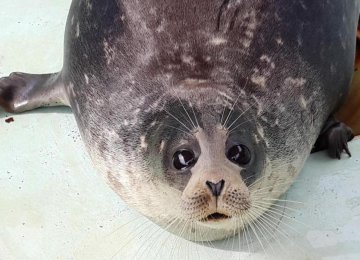T he 820 km stretch of the Caspian Sea coast in north Iran is not seeing much of its seal inhabitants these years. More than 20 years ago, however, people would see flocks of them swimming or resting on the shores. In the sea, when a seal was swimming, with its big dark eyes and long whiskers above water, one could easily mistake it for an elder man swimming around. The Caspian seals or sea-hounds live nowhere else but in the world’s largest inland body of water – the Caspian Sea - and play a crucial role in keeping its ecosystem healthy by topping its food chain.
Nevertheless, with passage of time, i.e. over the last three generations, the species has lost more than 50% of its population, winding up on the IUCN’s endangered species list. Recent surveys suggest that this decline has not ceased, but is ongoing. In Iran, unfortunately, the human factor has been reported as the main cause of mortalities.
Not long ago, negligent local fishers would beat the animals with paddles, believing them to be threats to their food supply. Also, many seals would, and still, get stuck to death in floating fishing nets, or get injured by boats. With the northern coasts of the Caspian Sea falling in the cold region of the planet, the seals are hurt in quite a different way. Apart from by-catch of seals in fisheries, when the hounds migrate to the north in winter in search of ice to breed, they are legally hunted for their skin and feather. Even their meat is used to feed fox breeding fields.
Apart from the human threat, the species suffers from other dangers: the overall ecosystem of the Caspian Sea has degraded much in recent times. Stocks of prey fish, mainly Caspian Kilka, have reduced drastically due to over-fishing and emergence of an invasive jellyfish species, ‘Mnemiopsis leidyi’, which has reportedly entered the sea through watercrafts’ ballast water -- a huge amount of water discharged or taken on by large tankers and bulk cargo carriers to maintain balance when the cargo is loaded or unloaded.
Other threats include: melting of the northern ice mass due to global warming and possible oil extraction procedures; pollution caused by agricultural toxins and industrial waste and oil leakage, which have found their way into the sea; and diseases such as Canine Distemper Virus (CDV) which have afflicted the species.
“In 2008, there were only 100,000 sea hounds in the sea as compared to over one million in the 1930s,” Dr. Amir Sayyad Shirazi, head of the Caspian Seal Rehabilitation and Research Project told the Financial Tribune.
Dutch Collaboration
Shirazi’s team officially started working on protecting the Caspian Seal in 2010. They were a group of Iranian veterinarians who were trained at the Seal Rehabilitation and Research Centre (SRRC) in the Netherlands. The SRRC is an organization mostly funded by charity, which enjoys a good record of bringing back the Netherlands’ seals, once in danger of extinction. The center spreads its 45-year knowledge in helping seals by training volunteers from around the world.
The seal clinic in Iran was set up in Ashouradeh Island, Golestan Province - a region hosting most of the seals coming to the southern shores of the Caspian Sea. The organization’s efforts include search and rescue, education of locals and employees of fisheries and organizations affiliated with the Department of Environment (DoE).
Education was desperately needed, Shirazi asserts, “Five years ago, the locals did not know how to treat this animal, as the issue of sea hounds was only raised by only one organization - Plan for the Land Society - before us in Iran,” he continues.
The center’s programs have turned the previously seal-hating local fishers into their ardent protectors. “Now, as soon as they find an injured or trapped seal, they quickly report it to the center, or take the animal there. The ones who bring a wounded seal to the clinic are rewarded $50, a part of which is intended to compensate for the usually torn net.”
“Many, however, refuse to take the money,” he adds.
Despite the fact that Iran ranks third among the five Caspian Sea countries – the others being Azerbaijan, Kazakhstan, Russian Federation, and Turkmenistan– in terms of the number of seals it receives, it has taken the lead in seal protection by establishing such a center, “We hope other countries would also start their own conservation activities,” Shirazi says.
Various protective measures have been taken by the littoral countries to conserve the Caspian Seal, such as the Seal Conservation Action and Management Plan which was approved by the abovementioned countries following the 2003 Framework Convention for the Protection of the Marine Environment of the Caspian Sea.
Although not futile, many of the measures were not sustainable enough or legally binding; the Russian Federation continues to consider the Caspian seal to be a harvestable species, and unsustainable quotas continue to be set through the Caspian Bio-Resources Commission; for example, a hunting quota of 18000 seals was set for the year 2007, making the slaughter of 18000 seals legal.
“We have taken steps to bring together the five countries to help the Caspian seal, and organizations such as the United Nations Environment Program (UNEP) and SRRC have contributed much along the way,” says Shirazi.
The five countries have so far met in the Netherlands, Russia, and Kazakhstan, and will gather in Iran in October. Shirazi is hopeful big strides will be made in the session, particularly in curbing seal hunting.
People’s Role
Bans or restrictions must be imposed on the fur and leather industry in Russia and Kazakhstan which hunt seals for their coat, “a task which will not be easy”, Shirazi states. “However, there is still hope, as we have held sessions to raise awareness among NGOs and people in those countries. When the NGOs are alert, they will do the rest: pressuring governments to take action,” he adds.
The clinic’s measures in Iran are mostly funded by international donors especially the Dutch, made possible through the SRRC.
Although in Iran donating to environmental causes is not as widespread as in the Netherlands, environmental education programs are commonplace. Last year, a 40-day educational event was held for protecting the Caspian Sea’s biodiversity with special focus on the seals as the sea’s only mammal.
Hor Mansouri Abdolmaleki, environmentalist and the event’s coordinator told the Financial Tribune, “The distressed ecosystem of the Caspian Sea, the largest lake on earth, can only be saved through abiding by sustainable harvest levels, periodical ceasing of hunting, creating protected areas for seals and other species, and reducing water pollution by controlling industrial and agricultural wastewaters finding their way into the sea, and most importantly educating people. Educating local communities is not enough. All people should be made aware because only in that case they can demand action from government.”





